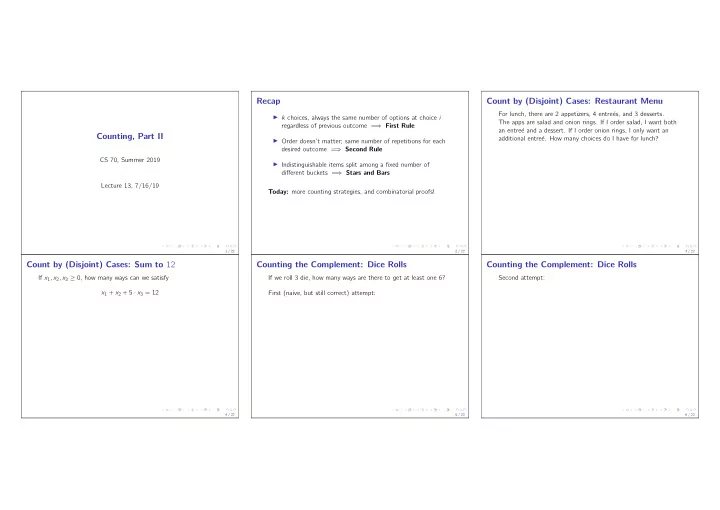

Recap Count by (Disjoint) Cases: Restaurant Menu For lunch, there are 2 appetizers, 4 entre´ es, and 3 desserts. ◮ k choices, always the same number of options at choice i The apps are salad and onion rings. If I order salad, I want both regardless of previous outcome = ⇒ First Rule an entre´ e and a dessert. If I order onion rings, I only want an Counting, Part II additional entre´ e. How many choices do I have for lunch? ◮ Order doesn’t matter; same number of repetitions for each desired outcome = ⇒ Second Rule CS 70, Summer 2019 ◮ Indistinguishable items split among a fixed number of different buckets = ⇒ Stars and Bars Lecture 13, 7/16/19 Today: more counting strategies, and combinatorial proofs! 1 / 22 2 / 22 3 / 22 Count by (Disjoint) Cases: Sum to 12 Counting the Complement: Dice Rolls Counting the Complement: Dice Rolls If x 1 , x 2 , x 3 ≥ 0, how many ways can we satisfy If we roll 3 die, how many ways are there to get at least one 6? Second attempt: x 1 + x 2 + 5 · x 3 = 12 First (naive, but still correct) attempt: 4 / 22 5 / 22 6 / 22
Counting Using Symmetry: Coin Flips Counting Using Symmetry: Coin Flips Counting Using Set Theory: Two Sets How many sequences of 16 coin flips have more heads than tails? Second attempt: Split the entire set of coin flips into three types: Assume A , B , C finite sets. | A ∪ B | = | A | + | B | − | A ∩ B | ( “ A or B ” / “at least one of A , B ” ) First (naive) attempt: 1. More heads than tails 2. More tails than heads 3. Equal numbers of heads and tails 7 / 22 8 / 22 9 / 22 Applying Set Theory: Phone Numbers Counting Using Set Theory: Three Sets Complete Mixups: Warm-Up How many 5-digit numbers have a 2 in the first or last position? | A ∪ B ∪ C | = | A | + | B | + | C |−| A ∩ B |−| B ∩ C |−| A ∩ C | + | A ∩ B ∩ C | Alice, Bob, and Charlie each bring a book to class. The books are ( “ A or B or C ” / “at least one of A , B , C ”) mixed up and redistributed. How many ways could Alice, Bob, and Charlie each not get their own book ? How many ways can Alice not get her own book, with no restrictions on Bob and Charlie? How many ways can Alice and Bob both not get their own book, with no restriction on Charlie? 10 / 22 11 / 22 12 / 22
Complete Mixups: A Realization Complete Mixups: Finishing Argument The Principle of Inclusion-Exclusion How many ways can Alice get her own book, with no restrictions A preview into the discrete probability section... on Bob and Charlie? A = Say we have n subsets of a space, A 1 , . . . , A n . B = � n � � � � A i � = ( size-1 intersections ) − ( size-2 intersections ) � � � � C = How many ways can Alice and Bob both get their own book, with � i = 1 no restrictions on Charlie? + ( size-3 intersections ) − . . . | A ∪ B ∪ C | = The “opposite” problem is easier! 13 / 22 14 / 22 15 / 22 Intro to Combinatorial Proof: Binomial Coefficients Pascal’s Triangle Combinatorial Proof I Powers of ( a + b ) : Observation #1: Pascal’s Triangle is symmetric. � n � n In other words: � = � ( a + b ) 0 = k n − k Algebraic Method: ( a + b ) 1 = ( a + b ) 2 = ( a + b )( a + b ) ( a + b ) 3 = ( a + b )( a + b )( a + b ) Double-Counting Method ( “Combinatorial Proof” ): How about ( a + b ) n ? This is the Binomial Theorem . ◮ Observation #1: ◮ Observation #2: ◮ Observation #3: 16 / 22 17 / 22 18 / 22
Combinatorial Proof II Combinatorial Proof III Another Combinatorial Proof � n � n � n − 1 � n − 2 � k Observation #3: Elements in row n sum to 2 n . � � � � � Observation #2: Adjacent elements sum to the element below. From Notes: = + + + . . . + k + 1 k k k k � n � n − 1 � n − 1 In other words: � n � n � � � � = 2 n In other words: = + k k − 1 k i = 1 i Algebraic Method: Don’t try this at home! Algebraic Method: Try it yourself! Algebraic Method: Don’t try this at home! Double-Counting Method ( “Combinatorial Proof” ): Double-Counting Method ( “Combinatorial Proof” ): Double-Counting Method ( “Combinatorial Proof” ): 19 / 22 20 / 22 21 / 22 Summary ◮ Other counting tools: casework, complements, symmetry... ◮ Set theory is your friend! Principle of inclusion / exclusion ◮ Counting problems will ask you to decide what tool to use and often combine strategies ◮ Combinatorial proof: count the same thing in two ways! 22 / 22
Recommend
More recommend